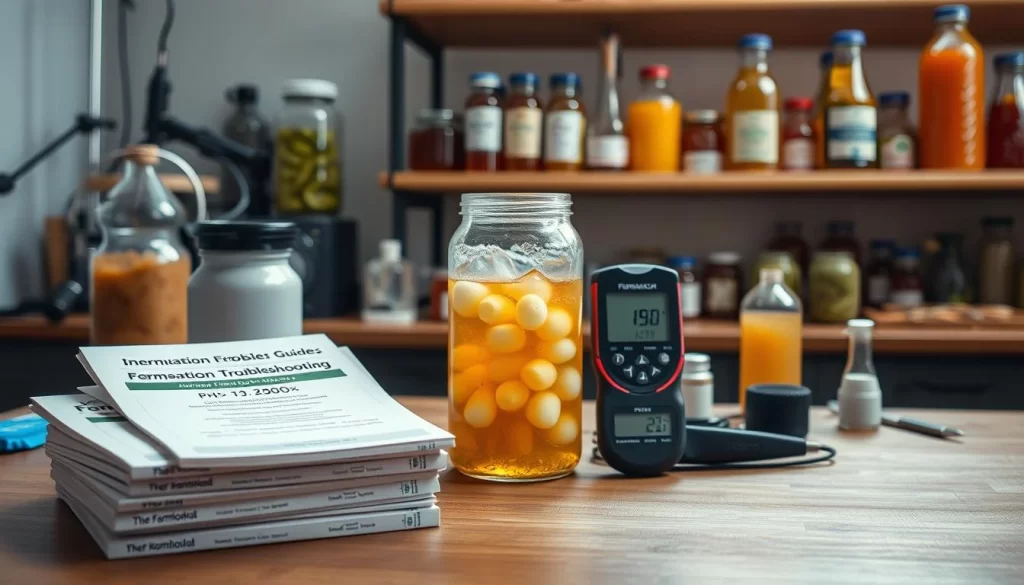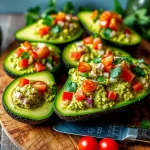For thousands of years, fermentation has turned simple ingredients into healthy dishes like sauerkraut and kimchi. This old method uses good bacteria like lactobacillus to keep food fresh and tasty. By learning fermentation, you open up a world of cookbook recipes that are both delicious and nutritious.
Since Wild Fermentation by Sandor Katz came out in 2003, many home cooks have taken to this tradition. The book offers 15 easy recipes, from yogurt to kombucha, showing how simple it is to start. With 26 scientific studies, including one from Stanford University, fermented foods improve gut health by adding to your microbiome. These foods also connect us to global cooking traditions, like French crème fraîche and Japanese miso.
Our guide makes fermentation easy with steps like heating jars to 180°C and checking them daily. Whether you’re making 500ml of sauerkraut or trying plant-based options, we aim for affordability and ease. With the right storage, your creations can last for months, making seasonal foods available all year. Let’s turn your kitchen into a place of creativity, one jar at a time.
Understanding the Ancient Art of Fermentation
Fermentation is more than a trend—it’s a tradition that has fed people for thousands of years. It started in ancient Mesopotamia and now is in our kitchens. This method keeps food fresh and brings out new flavors and nutrients.
At its core, fermentation uses microbes to break down sugars and starches. This creates tangy tastes and keeps food fresh longer. It also makes nutrients easier for our bodies to use.
For beginners, books like Sandor Katz’s The Art of Fermentation are great. They give step-by-step guides for making everything from sauerkraut to miso. This book is a deep dive into fermentation, mixing history, science, and practical tips.
Even busy people can learn fermentation easily. All you need is a jar, salt, and some veggies. Making pickles or trying Japanese miso connects us to healthy, sustainable traditions. With the right book, anyone can make delicious, nutritious meals at home.
The Gut-Brain Connection: How Fermented Foods Boost Overall Health
Recent studies show a strong link between gut health and brain function. The gut microbiome, with trillions of microorganisms, affects mood, immunity, and neurodegenerative disease risk. 90% of serotonin, which regulates mood, is made in the gut.
This connection means taking care of gut health through fermented foods can protect digestion and mental wellbeing.
Probiotics in foods like kefir, sauerkraut, and kimchi feed the gut microbiome. These beneficial bacteria reduce inflammation, support serotonin production, and influence brain signaling via the vagus nerve. Research suggests chronic gut inflammation may lead to Alzheimer’s or Parkinson’s.
For example, tempeh’s vitamin B12 and sauerkraut’s choline directly aid nerve function.
Modern diets, high in ultra-processed foods, disrupt this balance. Choosing whole foods like dandelion greens, garlic, and acacia gum—rich in prebiotics—alongside fermented options can counteract this trend. Our healthy cookbook recipes make it easy to add these foods to meals. Delicious cookbook recipes ensure taste remains a priority.
Prioritizing these ingredients supports a resilient microbiome, lowering inflammation risks and promoting stable energy and mood.
Essential Fermentation Styles and Their Unique Characteristics
Exploring different fermentation styles can really spark creativity in the kitchen. Lacto-fermentation turns veggies into tangy, probiotic-rich foods like sauerkraut and kimchi. These dishes use natural Lactobacillus bacteria, which grow well in salty environments.
Sandor Katz’s Wild Fermentation is a key resource, offering over 300 global techniques since 2003. His approach makes complex methods easy for home cooks to follow.
Dairy fermentation goes beyond yogurt to include artisanal cheeses. The Art of Fermentation teaches readers about cultures and aging, with 200+ cookbook recipes for all levels. For those interested in alcoholic ferments, The Noma Guide to Fermentation introduces new methods like vacuum-sealed ferments.
Even beginners can learn vinegar-making, a type of acetic acid fermentation. Fermented Vegetables shows 64 vegetable-based recipes. Each fermentation style needs specific conditions, like anaerobic setups for sauerkraut or oxygenated vessels for vinegar.
Resources like Fermentation Revolution and the New York Times-acclaimed Noma Guide offer detailed guides. They help home chefs blend traditional and modern methods. This way, they can discover new flavors and keep nutrients intact. Every fermentation style, from Korean kimchi to French crème fraîche, shares a story of culture and science.
Building Your Fermentation Pantry: Tools and Ingredients
Starting your fermentation journey doesn’t need a messy kitchen. Focus on the basics that spark creativity and keep things safe. You’ll need good salt, filtered water, and strong glass jars. Non-iodized sea salt or kosher salt is best for growing good bacteria. Use filtered water to avoid chlorine.
For containers, go for wide-mouth jars or ceramic crocks. Stay away from metals like aluminum or plastic.
Start with simple tools: a sharp knife, breathable cloths or airlock lids, and weights. A thermometer is also handy for keeping temperatures right, between 65–72°F. Starter cultures like water kefir grains or SCOBYs can come later. Most recipes start with veggies, salt, and water—no need for complicated steps.
Stock up with practical items from trusted brands. Masontops Fermentation Kits or half-gallon canning jars from Ball are good choices. For a limited time, use promo code MARYSNST for 15% off at Breadsmart or US Wellness Meats. Check out our free eBook, How to Stock Your Essential Traditional Foods Four-Corners Pantry, for more tips. Start with simple recipes like sauerkraut or fermented carrots. They’re quick, tangy, and ready in weeks. Focus on quality over quantity to build a strong foundation.
Delicious Cookbook Recipes for Fermentation Beginners
Starting your fermentation journey is easy. Our easy cookbook recipes are simple. For example, making sauerkraut just needs shredded cabbage, sea salt, and a wait of 1-2 weeks. It’s a great way to start, perfect for adding flavor to sandwiches or salads.
Try the Cultured Broccoli Salad for something different. Mix 2 broccoli heads, carrots, and red onion with lemon juice, kefir whey, and Himalayan salt. Then, pack it into jars and let it ferment for 3 days. It only takes 10 minutes to prepare, and it’s a tangy side dish.
Yogurt-making is also easy to start with. Heat milk to 180°F, cool it to 115°F, add a starter culture, and incubate for 4-8 hours. You can even use coconut milk yogurt for a dairy-free version. The 50 Fermentation Recipes cookbook has 50 ideas to try, and there are 9,126 fermenters ready to help you.
Don’t be afraid to add herbs like rosemary to Brussels sprouts or garlic to carrots. Each batch helps you learn more while keeping your meals interesting. Whether you’re making quick pickles or exploring kefir, these recipes show that fermentation is accessible to everyone.
Global Fermentation Traditions Worth Exploring
Exploring global fermentation traditions opens doors to vibrant flavors and cultural heritage. These methods have shaped diets worldwide. Popular cookbook recipes often highlight dishes like Korean kimchi, Japan’s miso, and Ethiopian injera. Each reflects centuries of knowledge, blending local ingredients with microbial science.
Japanese miso, used for over 1,300 years, is a great example. It’s made from soybeans, rice, or barley, fermented with koji mold. Today, 80% of Japan’s miso is rice miso, with flavors ranging from mild to robust. Ethiopian injera, a sourdough flatbread made from teff, is also gluten-free.
These traditions are not just historical—they’re alive in modern kitchens. Noma’s Copenhagen lab even uses fermentation creatively. They integrate elements like lacto-fermented pluots and mushrooms into every dish.
Cookbook recipes often feature these global staples. Korean kimchi, with its mix of napa cabbage, garlic, and chili powder, is now a pantry essential. Indonesian tempeh, made from soybeans bound by Rhizopus fungi, offers plant-based protein. Even lesser-known traditions, like Hawaiian poi (fermented taro) or Mexican curtido (a pickled cabbage relish), offer unique textures and flavors.
These traditions teach practical lessons. Korean kimchi uses precise salt ratios, while Japanese miso’s aging process—from weeks to years—alters taste. By adapting these techniques, you can recreate global flavors at home. Start with simple recipes and explore how fermentation bridges culture and nutrition.
Troubleshooting Common Fermentation Challenges
Fermentation challenges can happen even with simple recipes. We’re here to guide you through these issues with ease! First, make sure veggies stay under the brine. Use weights or stones to keep them submerged. A 2% salt-to-vegetable ratio is crucial: too little salt leads to spoilage, while too much makes veggies too salty.
If brine spills over, just skim it off and pack the jar again. White film on top? That’s kahm yeast, which is harmless. But if you see fuzzy or colorful mold, throw the batch away for safety.

Temperature is important! Keep your ferments at 65-75°F. Warmer temperatures speed up the process but might make the brine slimy. Store it in a cool pantry to balance.
Foaming is normal for veggies like beets, but strong smells over five days are a warning sign. For too salty ferments, soak veggies in fresh water for a few days. Always clean tools and jars to avoid contamination.
Our best cookbook recipes have clear steps to avoid common problems. For example, leave 1-2 inches of space in jars to prevent overflow. Need more help? Check out our free 36-page eBook on fermentation basics by signing up for our newsletter. The Modern Pioneer Cookbook also has tips for beginners.
Remember, even small issues are chances to learn. Adjust and try again! Invest in tools like the Masontops kit to make submersion easier. If you’re still unsure, join our Traditional Foods Kitchen Academy for detailed support. Fermentation is a journey—stay patient and curious. Find more kitchen tips in our best cookbook recipes here. Happy fermenting!
Advanced Fermentation Projects for Enthusiasts
Once you’ve learned the basics, dive into more complex projects. Start with sourdough starters, which are living cultures that adapt to your kitchen. They reflect your local environment through microbes and flour choices. This journey combines tradition and creativity, leading to the best cookbook recipes.
Try brewing kombucha next. Mix black or green tea, sugar, water, a SCOBY, and starter tea. This process takes 7–10 days and can be flavored with herbs or fruit. Mooncakes & Milk Bread (2022) offers healthy recipes that blend classic Chinese techniques with modern twists.
Move on to cheese-making and aged ferments. Start with fresh cheeses like paneer and then tackle aged miso or kimchi. The Noma Guide to Fermentation (2021) provides detailed guidance with over 750 photos. These projects require patience but offer intense flavors and textures.
Water kefir and shio koji are great for advanced cooks. Shio koji marinated for 7 days can enhance meats and vegetables. Water kefir, with its probiotic-rich base, can be flavored with fruit. Kristina Cho’s recipes mix traditional and innovative methods, connecting you to ancient practices while encouraging innovation.
Every project, from 10-month shio koji to 6-month miso, builds your skills and creativity. Join communities to share tips and solve problems. With practice, you’ll create items like effervescent kombucha or sourdough loaves. This proves that patience and curiosity lead to the best cookbook recipes. Let your pantry become a lab of flavor and tradition!
The Art of Incorporating Fermented Foods Into Your Daily Meals
Adding fermented foods to your meals is easy. Start with small amounts, like a spoonful of kimchi in scrambled eggs or yogurt in oats. Our quick cookbook recipes have ideas like sauerkraut-stuffed sandwiches or tangy relishes for grain bowls. A 2022 study in *Nutrients* found that fermented foods may lower heart disease and diabetes risks, making them a great choice for your diet.
For breakfast, try homemade apple-cider vinegar syrup on pancakes or kefir in smoothies. Lunch can be pickled veggies in salads or miso broth. Dinner? Stir fermented soy sauce into stir-fries or top tacos with kimchi slaw. Even a small amount, like a tablespoon of sauerkraut in soup or beet kvass in salad dressing, can make a difference.
Our cookbook has 70+ recipes, like Creamy Cashew Mac or Crispy Buffalo Cauliflower Wings, perfect for busy days. For more ideas, check out *Cultured Foods for Your Kitchen*, with 100+ dishes from around the world. Remember, don’t heat fermented foods above 110°F to keep the live cultures.
Start with basics: sauerkraut in breakfast scrambles, yogurt dips for snacks, or fermented sauces for grain bowls. Try making your own, like cucumber pickles with just salt, water, and a week. Small, regular servings are key for gut health, as experts suggest. With time, using fermented foods will feel as natural as seasoning with salt.
Fermenting for Special Dietary Needs: Vegan, Low-Sugar and Allergen-Free Options
Adapting ferments to dietary restrictions is easy. Our community loves plant-based ferments like coconut yogurt or tempeh. They’re featured in popular recipes like the 4.4-star vegan five-bean chili. Even classic ferments like sauerkraut or pickles are naturally vegan, needing just veggies, salt, and patience.
- Low-sugar options: Fermentation cuts natural sugars. Use stevia post-ferment or try our 4.6/5 coconut dhal.
- Allergen-free ferments: Swap wheat for Bob’s Red Mill gluten-free flour in sourdough. Soy-free? Chickpea miso or lentil ferments work.
- Oil-free recipes: Our 4.9/5 seasonal stew uses 1 tbsp oil max per dish.
Every recipe in Nourishing Meals includes substitutions like seed butters or low-FODMAP veggies. easy cookbook recipes focus on whole foods—no jargon, just clear steps. Whether avoiding dairy, gluten, or nuts, our strategies keep ferments probiotic-rich and approachable. Start with 365 allergen-free options and 24 rated recipes like the 4.6/5 rice-based kojis. Let’s make ferments work for everyone!
The Science Behind Fermentation’s Preservation Benefits
Fermentation uses nature’s defense systems. Lactic acid bacteria lower pH levels, making it hard for harmful microbes to survive. This acidity acts as a natural preservative, extending shelf life without artificial additives. When making quick cookbook recipes like kimchi or sauerkraut, these biological mechanisms work silently in your kitchen, ensuring safety and flavor.
Beneficial bacteria like lactobacillus produce probiotics that aid digestion and immune function. Studies show diets rich in fermented foods boost gut microbiome diversity. This supports metabolism and even influences mental well-being. For example, fermenting prebiotic-rich veggies like garlic or jicama (as seen in atchara recipes) combines probiotics with their food source, creating a dual boost for gut health.
Modern science confirms what traditions knew: fermentation enhances nutrition. The process breaks down anti-nutrients, unlocks minerals, and preserves vitamins. Unlike pasteurization, it retains enzymes that aid nutrient absorption. For busy cooks, this means healthy cookbook recipes like homemade yogurt or beet kvass offer concentrated nutrition with minimal effort.
As we blend ancient wisdom with modern understanding, remember: temperature control matters. Boiling brine solutions (like the 5-minute boil in atchara prep) ensures safety, while proper sealing prevents oxygen exposure. For more on foundational techniques, explore BBC Good Food’s guide. Pairing whole spices like cumin or mustard seeds (learn why at Comfort Food Cook) adds flavor and antimicrobial benefits.
Your Journey to Becoming a Fermentation Artisan Starts Now
Starting your fermentation journey is more than just following recipes. It’s about joining a tradition that feeds both your body and soul. Begin with simple recipes, like those in Emilie Raffa’s guide. It makes sourdough easy with overnight fermentation. Add flavor insights from spice mastery resources to take your dishes to the next level.
Start with recipes that fit your schedule. Sourdough starters need just flour, water, and daily care. Vegetable ferments like kimchi or sauerkraut are easy to prepare. Keep track of your progress with journals or calendars. Note how temperature and spice ratios change your creations.
Use trusted guides like Wild Fermentation by Sandor Katz or Modernist Bread for deeper knowledge. Even Chad Robertson’s famous Tartine method started small. Be patient: every step, from starter bubbles to crust crackling, is worth the wait.
Every ferment or dough connects you to ancient traditions and shapes today’s meals. Whether you’re adapting Elaine Boddy’s sourdough methods or trying new spice blends, fermentation is a daily journey of discovery. Let your curiosity lead you—your first loaf or jar is just the start of a lifelong craft.
Source Links
- https://www.wildfermentation.com/wild-fermentation-2nd-edition/
- https://theproof.com/ferments/
- https://www.bbcgoodfood.com/health/healthy-food-guides/beginners-guide-fermented-foods/
- https://www.wildfermentation.com/the-art-of-fermentation/
- https://www.thekitchn.com/the-art-of-fermentation-by-sandor-ellix-katz-174374
- https://food52.com/blog/19520-what-sandor-katz-wants-you-to-understand-about-fermentation?srsltid=AfmBOopjD53crEZvPih7xssGcZtrytzBcfbgYz1OX5Y_-M4EFdLjzu8i
- https://mcpress.mayoclinic.org/nutrition-fitness/heal-your-gut-save-your-brain/
- https://drperlmutter.com/eat/brain-maker-foods/
- https://www.birchwoodcounseling.com/post/brain-food-how-your-diet-affects-your-mood-and-why-you-should-care
- https://www.wildfermentation.com/wild-fermentation/
- https://www.seriouseats.com/fermented-hot-sauce-how-to
- https://revolutionfermentation.com/en/blogs/other/the-4-best-books-to-get-you-started-in-fermentation/
- https://marysnest.com/how-to-master-the-art-of-fermentation-part-1-overview/
- https://www.fermentingforfoodies.com/favourite-ferments/
- https://www.everand.com/book/292808258/50-Fermentation-Recipes-The-Beginner-s-Cookbook-to-Fermented-Eating-Includes-50-Recipes
- https://www.fermentationrecipes.com/
- https://www.howtocook.recipes/36-fermented-foods-from-around-the-world/
- https://culturesforhealth.com/blogs/news/a-trip-around-the-world-fermentation-around-the-world
- https://www.wired.com/story/noma-guide-to-fermentation-book-review/
- https://culturesforhealth.com/blogs/learn/natural-fermentation-fermented-vegetables-troubleshooting-faq
- https://www.fermentingforfoodies.com/fermentation-problems/
- https://marysnest.com/how-to-master-the-art-of-fermentation-part-2-anaerobic-fermentation/
- https://www.177milkstreet.com/radio/pickles-life-and-death-the-world-of-fermentation
- https://lacountystore.com/best-books-on-fermentation/
- https://www.seriouseats.com/shio-koji-marinade-recipe
- https://www.yahoo.com/lifestyle/fermented-foods-great-gut-health-103017012.html
- https://www.goodreads.com/book/show/16280120
- https://www.mediterraneanliving.com/cultured-foods-for-your-kitchen/
- https://itdoesnttastelikechicken.com/dietary-preferences/
- https://www.bbcgoodfood.com/recipes/collection/gluten-and-dairy-free-recipes
- https://www.equinox.com/articles/2023/09/the-science-backed-benefits-of-fermented-foods
- https://foodtrients.com/aging-gracefully/fermented-foods-preserve-our-health/
- https://thesourdoughjourney.com/books/
- https://myradicalroots.com/sourdough-guide/
- https://www.theperfectloaf.com/best-sourdough-recipe/














